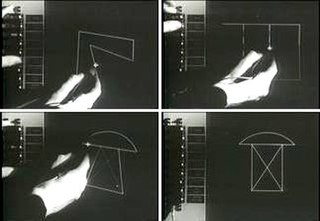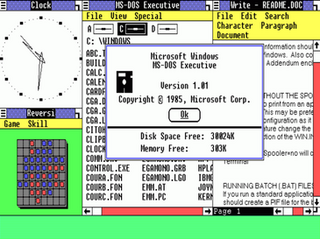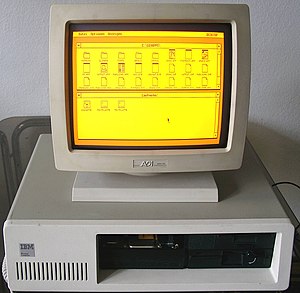
The Atari ST is a line of home computers from Atari Corporation and the successor to the Atari 8-bit family. The initial ST model, the 520ST, saw limited release in April–June 1985 and was widely available in July. The Atari ST is the first personal computer to come with a bitmapped color GUI, using a version of Digital Research's GEM released in February 1985. The 1040ST, released in 1986, is the first personal computer to ship with a megabyte of RAM in the base configuration and also the first with a cost-per-kilobyte of less than US$1.

The history of the graphical user interface, understood as the use of graphic icons and a pointing device to control a computer, covers a five-decade span of incremental refinements, built on some constant core principles. Several vendors have created their own windowing systems based on independent code, but with basic elements in common that define the WIMP "window, icon, menu and pointing device" paradigm.
DR-DOS is an operating system of the DOS family, written for IBM PC-compatible personal computers. It was originally developed by Gary A. Kildall's Digital Research and derived from Concurrent PC DOS 6.0, which was an advanced successor of CP/M-86. As ownership changed, various later versions were produced with names including Novell DOS and Caldera OpenDOS.

Digital Research, Inc. was a company created by Gary Kildall to market and develop his CP/M operating system and related 8-bit, 16-bit and 32-bit systems like MP/M, Concurrent DOS, FlexOS, Multiuser DOS, DOS Plus, DR DOS and GEM. It was the first large software company in the microcomputer world. Digital Research was based in Pacific Grove, California.

CP/M-86 was a version of the CP/M operating system that Digital Research (DR) made for the Intel 8086 and Intel 8088. The system commands are the same as in CP/M-80. Executable files used the relocatable .CMD file format. Digital Research also produced a multi-user multitasking operating system compatible with CP/M-86, MP/M-86, which later evolved into Concurrent CP/M-86. When an emulator was added to provide PC DOS compatibility, the system was renamed Concurrent DOS, which later became Multiuser DOS, of which REAL/32 is the latest incarnation. The DOS Plus, FlexOS, and DR DOS families of operating systems started as derivations of Concurrent DOS as well.

FreeGEM released in 1999 is a windowing system based on Digital Research's GEM which was first released in 1985. GEM stands for "Graphics Environment Manager".

OpenGEM is a non-multitasking 16-bit graphical user interface (GUI) for DOS. It is an extended distribution of FreeGEM that includes features of the original Digital Research GEM.
MiNT is Now TOS (MiNT) is a free software alternative operating system kernel for the Atari ST system and its successors. It is a multi-tasking alternate to TOS and MagiC. Together with the free system components fVDI device drivers, XaAES graphical user interface widgets, and TeraDesk file manager, MiNT provides a free TOS compatible replacement OS that can multitask.
EmuTOS is a replacement for TOS, released as free software. It is mainly intended to be used with Atari emulators and clones, such as Hatari or FireBee. EmuTOS provides support for more modern hardware and avoids the use of the old, proprietary TOS as it is usually difficult to obtain.

The Amstrad PC1512 was Amstrad's mostly IBM PC-compatible computer system, first manufactured in 1986. It was later succeeded by the PC1640.

A window manager is a system software that controls the placement and appearance of windows within a windowing system in a graphical user interface. Most window managers are designed to help provide a desktop environment. They work in conjunction with the underlying graphical system that provides required functionality—support for graphics hardware, pointing devices, and a keyboard, and are often written and created using a widget toolkit.

ViewMAX is a CUA-compliant file manager supplied with DR DOS versions 5.0 and 6.0. It is based on a cut-down version of Digital Research's GEM/3 graphical user interface modified to run only a single application, the ViewMAX desktop. Support for some unneeded functions has been removed whilst some new functions were added at the same time. Nevertheless, the systems remained close enough for ViewMAX to recognize GEM desktop accessories automatically and to allow some native GEM applications to be run inside the ViewMAX environment. Many display drivers for GEM 3.xx can be used by ViewMAX as well, enabling ViewMAX to be used with non-standard display adapters and higher resolutions than possible using the default set of ViewMAX drivers. Also, Digital Research's SID86, the symbolic instruction debugger that shipped with DR DOS 3.xx and provided dedicated functions to debug GEM applications, can be used for ViewMAX as well.
Timeworks Publisher was a desktop publishing (DTP) program produced by GST Software in the United Kingdom.

SpareMiNT is a software distribution based on FreeMiNT, which consists of a MiNT-like operating system (OS) and kernel plus GEM compatible AES.
FreeMint, MultiTOS, and MagiC are all successors to TOS, the proprietary operating system of the Atari ST computer and compatibles. Later models of the ST Computer were called the TT 030 and the Falcon 030. TOS stands for The Operating System or Tramiel Operating System, as Jack Tramiel was the then owner of Atari Corporation. GEMDOS itself was a near clone of PC DOS (supposedly), the then current IBM PC OS, and was programmed with assistance from Digital Research, where GEM was being developed. This was most visible to users in the 8.3 character file naming system, and the ability to read IBM PC formatted DOS disks. Like all personal computer operating systems of the day, Atari TOS was single tasking. GEM, the graphical user interface, was licensed from Digital Research and was not included in Apple's lawsuit against DRI, thus the Macintosh like appearance and ways of doing things remained on Atari ST computers. As time went on, the big goal for the Atari ST within and without Atari was to have a multi-tasking TOS.
TOS is the operating system of the Atari ST range of computers. This range includes the 520ST and 1040ST, their STF/M/FM and STE variants and the Mega ST/STE. Later, 32-bit machines were developed using a new version of TOS, called MultiTOS, which allowed multitasking. More recently, users have further developed TOS into FreeMiNT.
MagiC is a third party and now open-sourced multitasking-capable TOS-compatible operating system for Atari computers, including some newer clone systems manufactured later. There are also variants that run as part of Mac and PC emulation environments, as well as on macOS Intel-Mac computers.

Windows 1.0 is a graphical personal computer operating environment developed by Microsoft. Microsoft had worked with Apple Computer to develop applications for Apple's January 1984 original Macintosh, the first mass-produced personal computer with a graphical user interface (GUI) that enabled users to see user friendly icons on screen. Windows 1.0 was released on November 20, 1985, as the first version of the Microsoft Windows line. It runs as a graphical, 16-bit multi-tasking shell on top of an existing MS-DOS installation. It provides an environment which can run graphical programs designed for Windows, as well as existing MS-DOS software. Its development was spearheaded by the company founder Bill Gates after he saw a demonstration of a similar software suite known as Visi On at COMDEX.



















